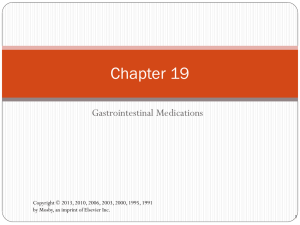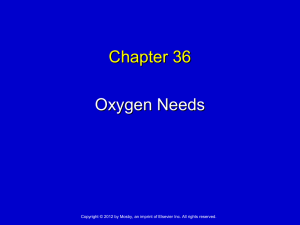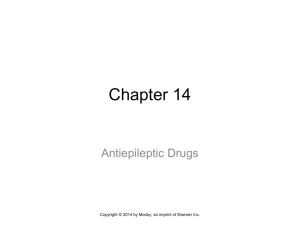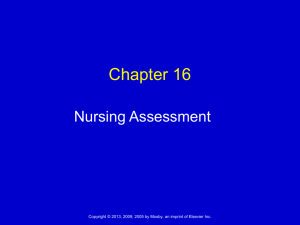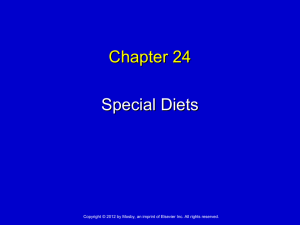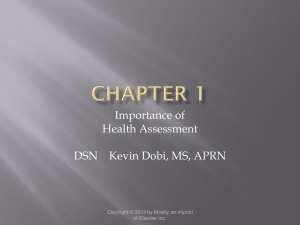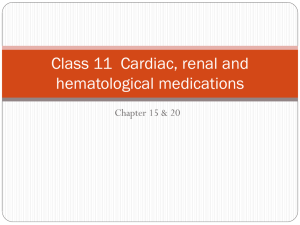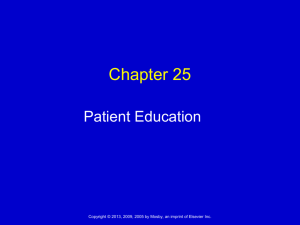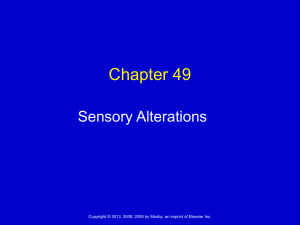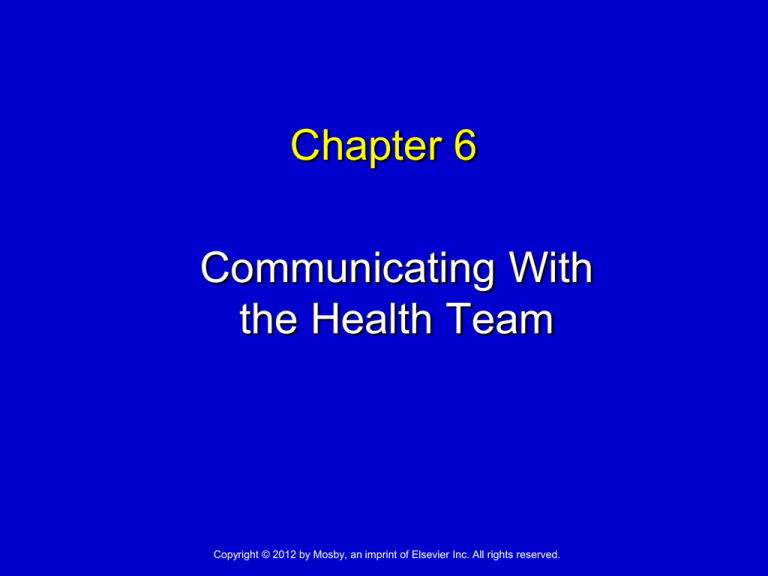
Chapter 6
Communicating With
the Health Team
Copyright © 2012 by Mosby, an imprint of Elsevier Inc. All rights reserved.
Communicating
With the Health Team
Health team members communicate with
each other to give coordinated and effective
care.
Health team members share information
about:
What was done for the person.
What needs to be done for the person.
The person’s response to treatment.
Copyright © 2012 by Mosby, an imprint of Elsevier Inc. All rights reserved.
Slide 2
Communication
Communication is the exchange of
information.
For good communication:
Use words that mean the same thing to you and
the receiver of the message.
Use familiar words.
Be brief and concise.
Give information in a logical and orderly manner.
Give facts and be specific.
Copyright © 2012 by Mosby, an imprint of Elsevier Inc. All rights reserved.
Slide 3
The Medical Record
The medical record is a written or electronic
account of a person’s condition and
response to treatment and care.
The health team uses it to share information
about the person.
The medical record is a permanent, legal
document.
Often it is used months or years later if the
person’s health history is needed.
It can be used in court as legal evidence of the
person’s problems, treatment, and care.
Copyright © 2012 by Mosby, an imprint of Elsevier Inc. All rights reserved.
Slide 4
The Medical Record (cont’d)
The record has many forms.
• They are organized into sections.
• Each page has the person’s name, room and bed
•
number, and other identifying information.
Health team members record information on the forms
for their departments.
Agency policies about medical records address:
• Who records
• When to record
• Abbreviations
• Correcting errors
• Ink color
• Signing entries
Copyright © 2012 by Mosby, an imprint of Elsevier Inc. All rights reserved.
Slide 5
The Medical Record (cont’d)
You must know your agency’s policies about
medical records and who can see them.
The following parts of the medical record relate
to your work.
• The admission record is completed when the person
•
is admitted to the center.
The health history (nursing history) is completed
when the person is admitted.
It contains the person’s background information and
health history.
Copyright © 2012 by Mosby, an imprint of Elsevier Inc. All rights reserved.
Slide 6
The Medical Record (cont’d)
•
•
•
The graphic sheet is used to record measurements
and observations made daily, every shift, or 3 to 4
times a day.
Progress notes describe the care given and the
person’s response and progress.
Flow sheets are used to record frequent
measurements or observations.
The Kardex
This is a type of card file that summarizes
information in the medical record.
• It is a quick, easy source of information about the
person.
Copyright © 2012 by Mosby, an imprint of Elsevier Inc. All rights reserved.
Slide 7
Reporting and Recording
The health team communicates by reporting
and recording.
Reporting is the oral account of care and
observations.
Recording (charting) is the written account of
care and observations. Reporting is the oral
account of care and observations.
Copyright © 2012 by Mosby, an imprint of Elsevier Inc. All rights reserved.
Slide 8
Reporting and Recording Time
Reporting and recording time
The 24-hour clock
Copyright © 2012 by Mosby, an imprint of Elsevier Inc. All rights reserved.
Slide 9
Reporting
Report to the nurse:
Whenever there is a change from normal or a
change in the person’s condition
When the nurse asks you to do so
When you leave the unit for meals, breaks, or for
other reasons
Before the end-of-shift (change-of-shift) report
Copyright © 2012 by Mosby, an imprint of Elsevier Inc. All rights reserved.
Slide 10
Reporting (cont’d)
End-of-shift (change-of-shift) report
The nurse reports information about:
• The care given
• The care to give during other shifts
• The person’s current condition
• Likely changes in the person’s condition
Copyright © 2012 by Mosby, an imprint of Elsevier Inc. All rights reserved.
Slide 11
Recording
When recording on the person’s chart, you
must communicate clearly and thoroughly.
Anyone who reads your charting should know:
• What you observed
• What you did
• The person’s response
Copyright © 2012 by Mosby, an imprint of Elsevier Inc. All rights reserved.
Slide 12
Medical Terms and
Abbreviations
Medical terms and abbreviations
If you do not understand a word or phrase,
communication does not occur.
Medical terms are made up of parts or word
elements.
A term is translated by separating the word into
its elements.
•
Prefixes, roots, and suffixes
Copyright © 2012 by Mosby, an imprint of Elsevier Inc. All rights reserved.
Slide 13
Medical Terms and
Abbreviations (cont’d)
A prefix is a word element placed before a root.
• Prefixes are always combined with other word
elements.
The root is the word element that contains the
basic meaning of the word.
• It is combined with another root, prefixes, and suffixes.
A suffix is a word element placed after a root.
• It changes the meaning of the word.
• Suffixes are not used alone.
• When translating medical terms, begin with the suffix.
Copyright © 2012 by Mosby, an imprint of Elsevier Inc. All rights reserved.
Slide 14
Medical Terms and
Abbreviations (cont’d)
The abdomen is divided into regions.
• Abdominal regions are used to describe the location of
•
body structures, pain, or discomfort.
The regions are:
Right upper quadrant (RUQ)
Left upper quadrant (LUQ)
Right lower quadrant (RLQ)
Left lower quadrant (LLQ)
Copyright © 2012 by Mosby, an imprint of Elsevier Inc. All rights reserved.
Slide 15
Medical Terms and
Abbreviations (cont’d)
Directional terms give the direction of the body part
when a person is standing and facing forward.
• Anterior (ventral)—at or toward the front of the body or
•
•
•
•
•
body part
Posterior (dorsal)—at or toward the back of the body or
body part
Proximal—the part nearest to the center or to the point of
origin
Distal—the part farthest from the center or from the point
of attachment
Lateral—away from the midline; at the side of the body or
body part
Medial—at or near the middle or midline of the body or
body part
Copyright © 2012 by Mosby, an imprint of Elsevier Inc. All rights reserved.
Slide 16
Medical Terms and
Abbreviations (cont’d)
Abbreviations
• Shortened forms of words or phrases
• Each agency has a list of accepted abbreviations.
•
Use only those abbreviations on the list.
If not sure about using an abbreviation, write the term
out in full.
Copyright © 2012 by Mosby, an imprint of Elsevier Inc. All rights reserved.
Slide 17
Computers and Other
Electronic Devices
Computer systems collect, send, record, and
store information (data).
Data are retrieved when needed.
Data are sent with greater speed and accuracy.
You must follow the agency’s policies when
using computers and other electronic
devices.
You must keep protected health information
(PHI) and electronic PHI confidential.
Copyright © 2012 by Mosby, an imprint of Elsevier Inc. All rights reserved.
Slide 18
Phone Communications
Good communication skills are needed.
You give much information by:
Your tone of voice
How clearly you speak
Your attitude
Copyright © 2012 by Mosby, an imprint of Elsevier Inc. All rights reserved.
Slide 19
Dealing with Conflict
The problem-solving process involves these
steps.
Step 1: Define the problem.
Step 2: Collect information about the problem.
Step 3: Identify possible solutions.
Step 4: Select the best solution.
Step 5: Carry out the solution.
Step 6: Evaluate the results.
Copyright © 2012 by Mosby, an imprint of Elsevier Inc. All rights reserved.
Slide 20
Dealing With Conflict (cont’d)
To deal with conflict:
Ask your supervisor for some time to talk privately.
Approach the person you have the conflict with.
Agree on a time and place to talk.
Talk in a private setting.
Explain the problem and what is bothering you.
Listen to the person.
Identify ways to solve the problem.
Set a date and time to review the matter.
Thank the person for meeting with you.
Carry out the solution.
Review the matter as scheduled.
Copyright © 2012 by Mosby, an imprint of Elsevier Inc. All rights reserved.
Slide 21

